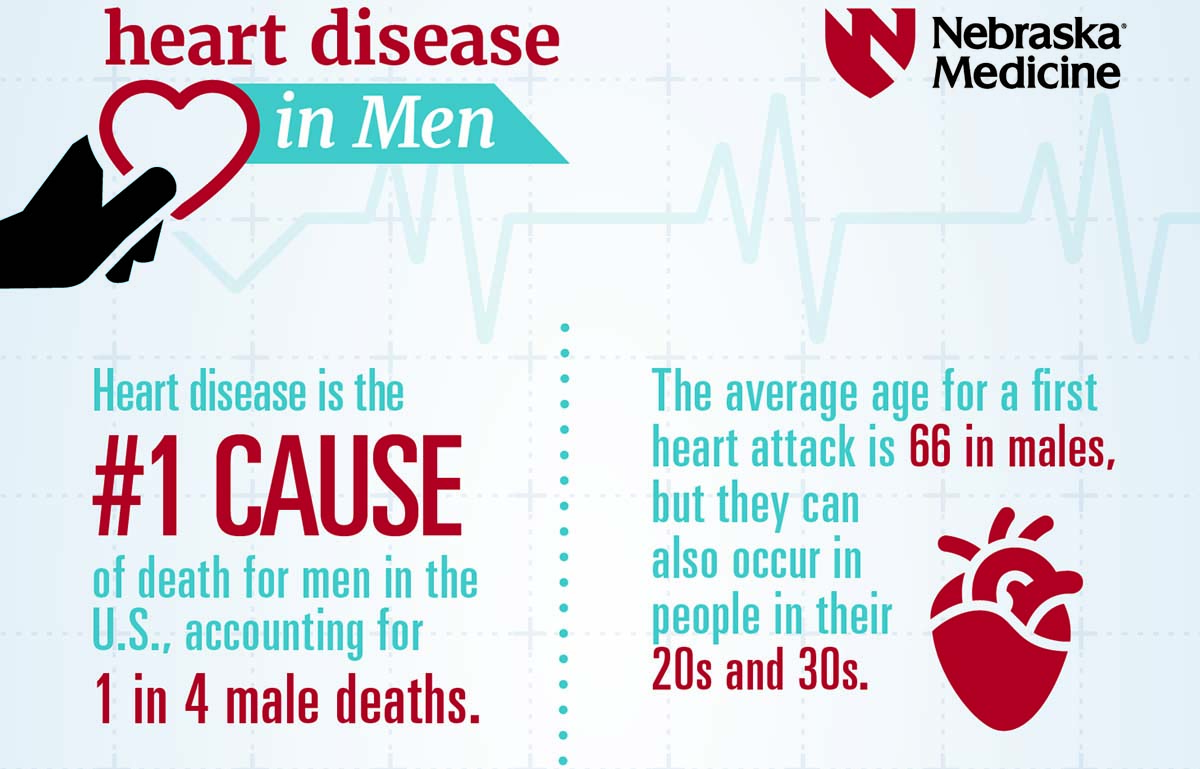Men, know your heart attack symptoms and take action

Pause for a moment and think about a male member of your family, your circle of friends or someone at work. It may be you or someone’s grandfather, father, brother or husband. The one thing they all have in common is that they are at risk of developing heart disease, the No. 1 killer of men in the U.S.
In 2017, heart disease claimed the lives of 347,879 men in this country. That is 1 in 4 male deaths due to heart disease. Half of the men who die suddenly of heart disease have no warning signs. We generally think of heart disease as something that affects older people, but it starts earlier in life. Many people in their 30s and 40s have had heart attacks.

Now is the time to take steps to reduce the risk of heart disease. Know the risk factors. Know how you can reduce your risk of heart disease.
Risk Factors for Heart Disease1,2
- Diabetes
- Overweight and obesity
- Unhealthy diet
- Physical inactivity
- Excessive alcohol use
- Smoking
- Family history/genetics
- High cholesterol
How Do You Reduce Your Risk of Heart Disease?
The American Heart Association has developed a simplified approach to reducing the risk of developing heart disease.
Life's Simple 7 Approaches to Heart Healthy: American Heart Association (2019)
- Keep a healthy weight.
- Learn about cholesterol.
- Don’t smoke or use smokeless tobacco.
- Eat a heart-healthy diet.
- Keep blood pressure healthy.
- Be physically active.
- Learn about blood sugar and diabetes.
1. Keep a Healthy Weight
Forty percent of adults over the age of 20 years old in the U.S. are obese. The number jumps up to 72% with the inclusion of those who are overweight. There is no perfect way to measure weight status, but the most common and cheapest is the body mass index (BMI). It is based on the height and weight of the individual. It can be used as a screening tool with a normal range of 18.5 to 24.9. Obesity is defined as a BMI of 30 or higher. Excess belly fat can increase your risk of heart disease. You have excess belly fat if your belly (waist) is more than 40 inches for men.
2. Learn About Cholesterol
You have probably heard that you want your good cholesterol or HDL (high-density cholesterol) to be high and your bad cholesterol (low-density cholesterol) to be low. Then there is the total cholesterol amount, and what about my triglycerides? The most important thing to remember is to get your cholesterol checked and talk to your health care provider about it.
3. Smoking
The data is very clear; smoking contributes to many diseases, including heart disease. Every year in the U.S., secondhand smoke causes nearly 34,000 early deaths from coronary heart disease among nonsmokers. Bottom line, don’t smoke and don’t be around those who do.
4. Heart-healthy Diet (AHA, CDC recommendations)
A heart-healthy diet includes:
- Fresh fruit and vegetables
- Whole grains
- Nuts and legumes
- Nontropical vegetable oils
- Low-fat, low-salt foods
Limit the following:
- Alcohol (only 2 drinks a day for men, 1 drink a day for women)
- Saturated fats
- Sodium (less than 2.300 mg/day)
- Sweets and sugar-sweetened beverages
- Red meats (select leanest cuts)
4. Check Your Blood Pressure
High blood pressure can contribute to heart disease. You can have it checked at your health care provider’s office or obtain a home blood pressure kit. The home blood pressure kit will let you and your provider know your blood pressure in your everyday living or work environment. Treatment may include lifestyle changes and medications.
5. Get Physically Active
The American Heart Association recommends 150 minutes of moderate physical activity or 75 minutes of vigorous physical activity every week. Set up a regular exercise schedule. Write it down, post it in view (refrigerator, front door), tell your friends and family about it. Make it a routine. The authors of “Younger Next Year,” Chris Crowley and Henry Lodge, MD, write, “After age 50, exercise is no longer optional, you must do it.”
6. Learn About Blood Sugar and Diabetes
Diabetes damages the blood vessels and nerves in your heart over time and increases the risk of heart disease by two-fold. The good news is diabetes can generally be controlled with medicine and lifestyle changes. Your health care provider can screen you for diabetes.
Genetics is a well-known risk factor for heart disease. If your parents or siblings have had heart disease, then you are at an increase for it. Fortunately, this is only one of the risk factors. You can have an impact on the other risk factors.

3 Things to Take Away
- Heart disease is the No. 1 cause of death in males in the U.S.
- It can be a silent killer and starts early in life.
- See your health care provider to see if you or someone you know is at risk today.
Sources:
1. Center for Disease Control, www.cdc.gov
2. American Heart Association, www.heart.org




